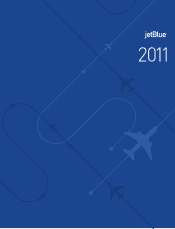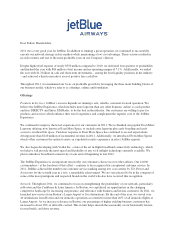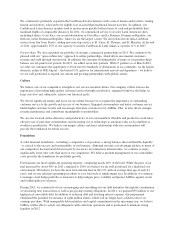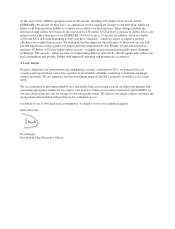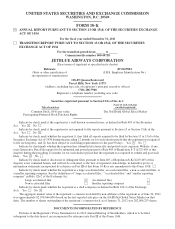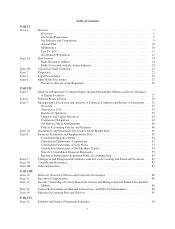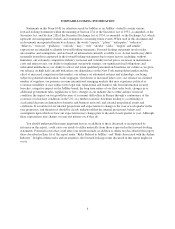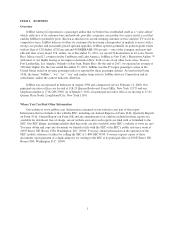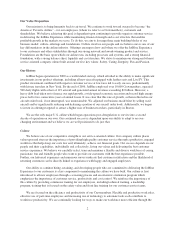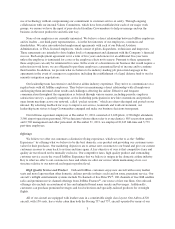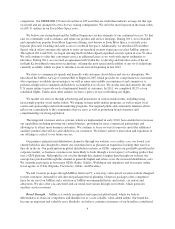JetBlue Airlines 2011 Annual Report Download - page 4
Download and view the complete annual report
Please find page 4 of the 2011 JetBlue Airlines annual report below. You can navigate through the pages in the report by either clicking on the pages listed below, or by using the keyword search tool below to find specific information within the annual report.We continued to profitably expand in the Caribbean & Latin America with a mix of leisure and travelers visiting
friends and relatives, who tend to be slightly less seasonal than traditional leisure travelers. In addition, our
Caribbean & Latin America markets tend to mature more quickly both in terms of cash and profitability than
mainland flights of comparable distances. In 2011, we commenced service to six new Latin American cities,
including Liberia, Costa Rica, our second destination in Costa Rica, and La Romana, Dominican Republic, our
fifth city in the Dominican Republic, where we are the largest carrier. We also bolstered our intra-Caribbean
service from San Juan, Puerto, adding new non-stop service to St. Croix, St. Thomas, and St. Maarten. At the end
of 2011, approximately 25% of our capacity was in the Caribbean & Latin America, up from 11% in 2007.
Partnerships: We also expanded our portfolio of strategic commercial partnerships in 2011. We continue to be
pleased with our “open architecture” approach to airline partnerships, which drives incremental customers,
revenue and yield through our network. In addition, the customer booking profile of many of our partners helps
balance our off-peak travel periods. In 2011, we added seven new partners. With 17 partners as of March 2012,
we offer our customers the opportunity to book travel to hundreds of destinations in six continents. As the largest
domestic airline at JFK Airport – the busiest U.S. gateway for international arrivals and departures – we believe
we are well positioned to expand our current and growing partnerships with global carriers.
Culture
We believe one of our competitive strengths is our service-oriented culture. Our company culture stresses the
importance of providing high-quality customer service through a productive, engaged workforce that helps us
keep costs low and, ultimately, achieve our financial goals.
We devote significant energy and focus on our culture because we recognize the importance of outstanding
customer service to the growth and success of our business. Engaged crewmembers and better customer service
builds higher customer loyalty and encourages first-time customers to try JetBlue. This, in turn, drives stronger
revenue performance and contributes meaningfully to profitability.
We are also focused on the efficiency and productivity of our crewmembers. Flexible and productive work rules,
effective use of part-time crewmembers and increasing use of technology to automate tasks each contribute to
workforce productivity. We believe our unique culture and direct relationship with our crewmembers will
provide the foundation for future success.
Foundation
A solid financial foundation – including a competitive cost position, a strong balance sheet and healthy liquidity
– is critical to the success and sustainability of our business. Although our unit cost advantage relative to many of
our competitors has narrowed driven in part by necessary investments in infrastructure, we continue to enjoy
significantly lower unit costs than most of our competitors. We believe prudent management of our controllable
costs provides the foundation for profitable growth.
Fuel remains our most significant operating expense, comprising nearly 40% of the total. While the price of jet
fuel increased by about 40% in 2011 compared to 2010, we believe we are well positioned for a high fuel cost
environment. We believe we have the most fuel efficient fleet in the U.S. with an average fleet age of only 6.1
years, and we use efficient operating procedures to save fuel such as single engine taxi. In addition, we continue
to manage a fuel hedge portfolio as insurance to help mitigate price volatility and protect JetBlue against severe
and sudden spikes in oil prices.
During 2011, we continued to focus on managing and smoothing out our debt maturities through the combination
of structuring new transactions as well as pre-paying existing obligations. In 2011, we prepaid $39 million of our
high-priced convertible debt. In addition to reducing debt and lowering interest expense, this prepayment
eliminated the potential for issuance of eight million shares, which will no longer have a dilutive effect on
earnings per share. With manageable debt maturities and capital commitments in the upcoming year, we believe
JetBlue will be able to satisfy our obligations with cash from operations and is positioned to maintain strong
liquidity in 2012.

